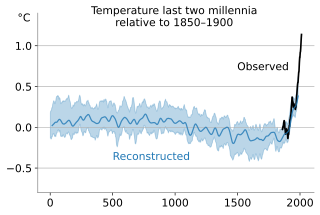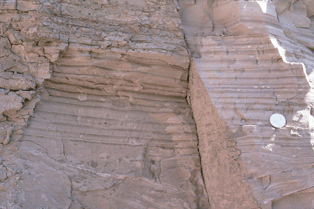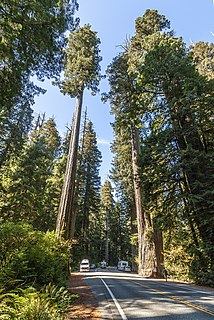Related Research Articles

Götterdämmerung, WWV 86D, is the last in Richard Wagner's cycle of four music dramas titled Der Ring des Nibelungen. It received its premiere at the Bayreuth Festspielhaus on 17 August 1876, as part of the first complete performance of the Ring.

Wood is a porous and fibrous structural tissue found in the stems and roots of trees and other woody plants. It is an organic material – a natural composite of cellulose fibers that are strong in tension and embedded in a matrix of lignin that resists compression. Wood is sometimes defined as only the secondary xylem in the stems of trees, or it is defined more broadly to include the same type of tissue elsewhere such as in the roots of trees or shrubs. In a living tree it performs a support function, enabling woody plants to grow large or to stand up by themselves. It also conveys water and nutrients between the leaves, other growing tissues, and the roots. Wood may also refer to other plant materials with comparable properties, and to material engineered from wood, or wood chips or fiber.

Dendrochronology is the scientific method of dating tree rings to the exact year they were formed. As well as dating them this can give data for dendroclimatology, the study of climate and atmospheric conditions during different periods in history from wood. Dendrochronology derives from Ancient Greek dendron (δένδρον), meaning "tree", khronos (χρόνος), meaning "time", and -logia (-λογία), "the study of".

A wildfire, bushfire, wildland fire or rural fire is an unplanned, unwanted, uncontrolled fire in an area of combustible vegetation starting in rural areas and urban areas. Depending on the type of vegetation present, a wildfire can also be classified more specifically as a forest fire, brush fire, bushfire, desert fire, grass fire, hill fire, peat fire, prairie fire, vegetation fire, or veld fire. Many organizations consider wildfire to mean an unplanned and unwanted fire, while wildland-fire is a broader term that includes prescribed fire as well as wildland fire use.

Quercus stellata, the post oak or iron oak, is a North American species of oak in the white oak section. It is a slow-growing oak that lives in dry areas on the edges of fields, tops of ridges also grows in poor soils, and is resistant to rot, fire, and drought. Interbreeding occurs among white oaks, thus many hybrid species combinations occur.

In the study of past climates ("paleoclimatology"), climate proxies are preserved physical characteristics of the past that stand in for direct meteorological measurements and enable scientists to reconstruct the climatic conditions over a longer fraction of the Earth's history. Reliable global records of climate only began in the 1880s, and proxies provide the only means for scientists to determine climatic patterns before record-keeping began.

A varve is an annual layer of sediment or sedimentary rock.

The global temperature record shows the fluctuations of the temperature of the atmosphere and the oceans through various spans of time. The most detailed information exists since 1850, when methodical thermometer-based records began. There are numerous estimates of temperatures since the end of the Pleistocene glaciation, particularly during the current Holocene epoch. Older time periods are studied by paleoclimatology.
Absolute dating is the process of determining an age on a specified chronology in archaeology and geology. Some scientists prefer the terms chronometric or calendar dating, as use of the word "absolute" implies an unwarranted certainty of accuracy. Absolute dating provides a numerical age or range in contrast with relative dating which places events in order without any measure of the age between events.

The Minoan eruption was a major catastrophic volcanic eruption that devastated the Aegean island of Thera in around 1600 BCE. It destroyed the Minoan settlement at Akrotiri, as well as communities and agricultural areas on nearby islands and the coast of Crete with subsequent earthquakes and tsunamis. With a VEI magnitude between 6 and 7, resulting in an ejection of approximately 60 km3 (14 cu mi) of dense-rock equivalent (DRE), the eruption was one of the largest volcanic events on Earth in human history.
Thomas W. Swetnam is Regents' Professor Emeritus of Dendrochronology at the University of Arizona, studying disturbances of forest ecosystems across temporal and spatial scales. He served as the Director of the Laboratory of Tree-Ring Research from 2000 to 2015.

A stem is one of two main structural axes of a vascular plant, the other being the root. It supports leaves, flowers and fruits, transports water and dissolved substances between the roots and the shoots in the xylem and phloem, stores nutrients, and produces new living tissue.

In botany, a tree is a perennial plant with an elongated stem, or trunk, supporting branches and leaves in most species. In some usages, the definition of a tree may be narrower, including only woody plants with secondary growth, plants that are usable as lumber or plants above a specified height. In wider definitions, the taller palms, tree ferns, bananas, and bamboos are also trees. Trees are not a taxonomic group but include a variety of plant species that have independently evolved a trunk and branches as a way to tower above other plants to compete for sunlight. Trees tend to be long-lived, some reaching several thousand years old. Trees have been in existence for 370 million years. It is estimated that there are some three trillion mature trees in the world.
Malcolm K. Hughes is a meso-climatologist and Regents' Professor of Dendrochronology in the Laboratory for Tree-Ring Research at the University of Arizona.

Sequoia sempervirens is the sole living species of the genus Sequoia in the cypress family Cupressaceae. Common names include coast redwood, coastal redwood and California redwood. It is an evergreen, long-lived, monoecious tree living 1,200–2,200 years or more. This species includes the tallest living trees on Earth, reaching up to 115.5 meters (379 ft) in height and up to 8.9 meters (29.2 ft) in diameter at breast height (dbh). These trees are also among the oldest living things on Earth. Before commercial logging and clearing began by the 1850s, this massive tree occurred naturally in an estimated 810,000 hectares along much of coastal California and the southwestern corner of coastal Oregon within the United States.
Keith Raphael Briffa was a climatologist and deputy director of the Climatic Research Unit. He authored or co-authored over 130 scholarly articles, chapters and books. In his professional work, he focused on climate variability in the late Holocene, with a special focus on northern portions of Europe and Asia. Briffa's preferred method was dendroclimatology, which is a set of procedures intended to decode information about the past climate from tree rings. Briffa helped develop data sets from trees from Canada, Fennoscandia, and northern Siberia which have been used in climate research.
James H. Speer is a professor of geography and geology at Indiana State University. He is a past president of the Tree-Ring Society and the Geography Educator's Network of Indiana. He has been the organizer for the North American Dendroecological Fieldweek (NADEF) since 2003.
Susan "Sue" Speer C.Psychol, FHEA is a senior lecturer at the School of Psychological Sciences, University of Manchester.
Fire history, the ecological science of the study of the history of wildfires, is a subdiscipline of fire ecology. Patterns of forest fires in historical and prehistorical time provide information relevant to the pattern of vegetation in modern landscapes. It provides an estimate of the historical range of variability of a natural disturbance regime, and can be used to identify the processes affecting the occurrence of fire. Fire history reconstructions are achieved by compiling atlases of past fires, using the tree ring record from fire scars and tree ages, and the charcoal record from soils and sediments.
References
- ↑ Wang, Xiao-Chun; Ji, Ying (2009). "Review of Advances in Dendropyrochronology". Chinese Journal of Plant Ecology. 33 (3). doi:10.3773/j.issn.1005-264x.2009.03.018.
- ↑ Cassell, Brooke A.; Alvarado, Ernesto (2012). "Reconstruction of fire history in Mexican tropical pines using tree rings". The Forestry Chronicle. 88 (5): 553–555. doi:10.5558/tfc2012-105.
- ↑ Speer, James H. Speer (2010). Fundamentals of Tree-ring Research. University of Arizona Press. pp. 194–218. ISBN 978-0816526840.